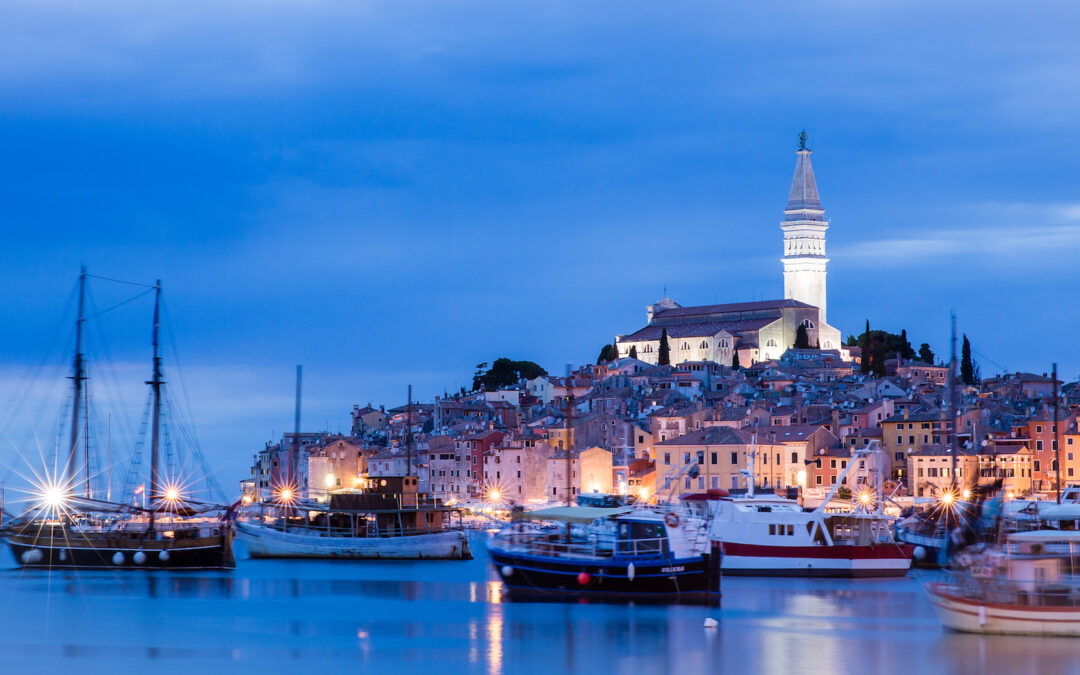As a native of Croatia, I have always been blessed to live in such a paradise; the array of topography, flora, fauna, tastes and sounds, never gets old. Sometimes you just need a little well-deserved getaway for inspiration and to sooth your soul; what better way than to hop in your car, travel a few hours, and visit Rovinj. Join me!
There is so much to do and see in Rovinj, so let us make this seaside city our home base for our daily adventures. Rovinj, whose historic core, (old town), is mostly Venetian, was built with pale limestone that glows in the sun. Houses hug one another all the way down to the seafront, and cobblestone streets lead to the hilltop church of St. Euphemia, dominating the skyline. City center is quaint, full of restaurants and cafes, and we will always find time for a delicious nibble, to watch this ancient town go about its day.
The Cathedral of St. Euphemia, recognizable near and afar, sports a baroque campanile, and closely resembles St. Mark’s in Venice. It’s no surprise that the 17th-century St. Euphemia was built by the Venetians, who were in control of Rovinj throughout this period. To get the lie of the land you can make your way up the campanile, which is 200 feet high and offers views of the Alps to the north on a clear day. The church’s interior boasts some sumptuous designs, including a marble altar with a 15th-century statue of the saint, before a sarcophagus containing Euphemia’s relics.
Rovinj’s Heritage Museum was founded by a group of Rovinj’s artists in the 1950s as a way of bringing together the area’s cultural wealth, and displaying the work of local painters and sculptors. These is a gallery space here with some 1500 pieces of contemporary art, next to exhibit rooms with important artefacts relating to the various cultures that settled in Rovinj, and the city’s rich maritime history. The museum’s grand home is a big part of its appeal; it’s a four-story baroque palace built by the Counts of Califfi in the 1600s.
Leading to Grisia Street away from the main square is the imposing Balbi’s Arch from the late 1670s, named after Daniel Balbi, who was the mayor at the time. The arch replaced an old town gate and bears the classic Venetian hallmark of the Lion of St. Mark. Curiously there are also two stone heads, one on either side of the arch; on one you can make out the head of a bearded Venetian, and on the other there’s a Turk, wearing a turban.
We are working up an appetite after exploring this beautiful town, and drawing in the aromas wafting through the town. For our culinary focused travelers, let us experience a genuine taste of Istria, and dine on fuzi pasta, which is the local pasta variety. These are small rolled sheets (relatively similar to penne) served with a veal sauce made with wine and tomatoes. In many restaurants, it is custom to grate white truffle on top. Truffles grow in abundance in central Istria’s damp oak forests, and in fact, the all-time largest in the world was discovered outside of Buje in 1999, weighing almost three pounds! Istria’s Italian connection is evident from the amount of traditional oven pizzerias in towns like Rovinj; why not maximize the best of everything and order their famous seafood pizza!
Visit our blog page, for some of our other adventures in this profoundly beautiful part of Croatia. Each day we will be visiting Istria’s magnificent sites, such as the beaches and ports, Pula and its renowned amphitheater, Monkodonja’s archaeological site, the medieval town of Dvigrad, Lim Fjords, and Brijuni National Safari Park, to name a few. Food, friends and fun await you!
